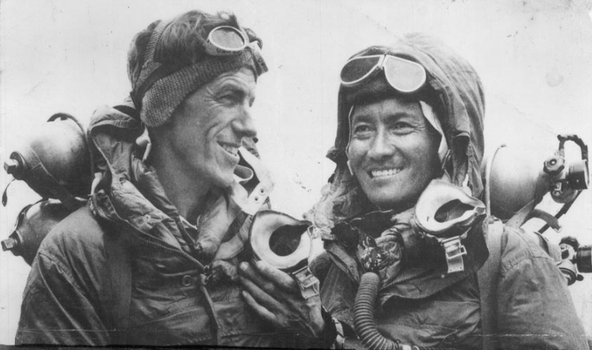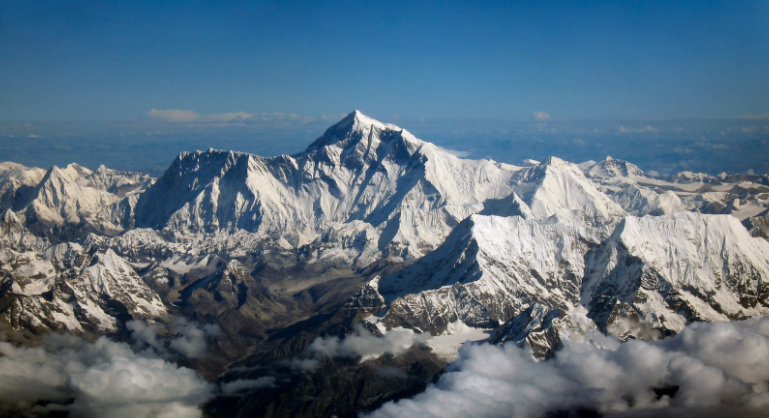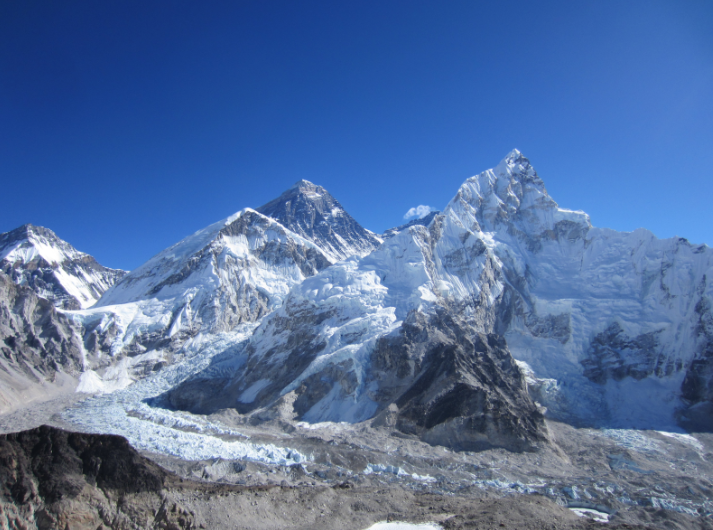Enigma on Everest
|
The disputed of Mallory-Irvine summit attempt.
|
Written by Nate Aleshire
|

Ever since Mount Everest was recognized as the tallest peak in the world, it has occupied the minds of mountaineers. There were decades of debate over whether or not it was even possible to summit Everest. 1885 is the earliest record of a climber, arguing that it was even feasible to scale the zenith. Even so, mountaineers were unable to enter the area until the early 1920s, as Nepal and Tibet, the two countries that contain Mount Everest, refused to allow outsiders within their borders.
The first real efforts to climb began once a British expedition was able to negotiate with one of the country's passages to Everest. With help from the Dalai Lama, Tibet allowed the expedition access to the mountain. In 1921, an exploratory expedition sought to find a pathway to the summit, and it was largely headed by George Leigh Mallory after many of the other, more qualified candidates were in too poor health to assume that responsibility. The 1921 group thoroughly studied Everest for months, but were kept from progressing too far up the mountain by extreme weather conditions.
Leading the 1921 British team gave Mallory the experience and reputation to head another British group the next year, this time with the intention of summiting Everest. However, the 1922 attempt was short-lived, as the team mistakenly began too soon after a heavy snowfall. This caused an avalanche that killed seven Sherpas who were part of the team. With a devastated expedition group, and a mind wracked with guilt, Mallory canceled the 1922 attempt.
Mallory made his final attempt during 1924, leading yet another British team. This time, a key party member was Andrew Irvine, a 22-year-old with no experience of climbing in high-altitudes, and no experience in the extreme terrain of the Himalayas. However, Irvine was particularly skilled at operating, maintaining, and experimenting with oxygen equipment. Soon after attempts to climb Everest began, it became clear to some mountaineers that bottled oxygen was a necessity for any would-be summiters. Mallory, after his past failures in 1921 and 1922, believed that oxygen was essential for climbers, and accordingly brought in Irvine as his oxygen expert. It should be noted here though, that the oxygen apparatus Irvine brought and was most experienced with was experimental, and he made tweaks to the mechanisms periodically throughout the journey. Irvine was able to make the oxygen canister systems that he worked on about five pounds lighter than the standard set, but the oxygen canisters themselves were notoriously unreliable. More than three dozen canisters had already been found to have leaked on Everest in that year.
The first real efforts to climb began once a British expedition was able to negotiate with one of the country's passages to Everest. With help from the Dalai Lama, Tibet allowed the expedition access to the mountain. In 1921, an exploratory expedition sought to find a pathway to the summit, and it was largely headed by George Leigh Mallory after many of the other, more qualified candidates were in too poor health to assume that responsibility. The 1921 group thoroughly studied Everest for months, but were kept from progressing too far up the mountain by extreme weather conditions.
Leading the 1921 British team gave Mallory the experience and reputation to head another British group the next year, this time with the intention of summiting Everest. However, the 1922 attempt was short-lived, as the team mistakenly began too soon after a heavy snowfall. This caused an avalanche that killed seven Sherpas who were part of the team. With a devastated expedition group, and a mind wracked with guilt, Mallory canceled the 1922 attempt.
Mallory made his final attempt during 1924, leading yet another British team. This time, a key party member was Andrew Irvine, a 22-year-old with no experience of climbing in high-altitudes, and no experience in the extreme terrain of the Himalayas. However, Irvine was particularly skilled at operating, maintaining, and experimenting with oxygen equipment. Soon after attempts to climb Everest began, it became clear to some mountaineers that bottled oxygen was a necessity for any would-be summiters. Mallory, after his past failures in 1921 and 1922, believed that oxygen was essential for climbers, and accordingly brought in Irvine as his oxygen expert. It should be noted here though, that the oxygen apparatus Irvine brought and was most experienced with was experimental, and he made tweaks to the mechanisms periodically throughout the journey. Irvine was able to make the oxygen canister systems that he worked on about five pounds lighter than the standard set, but the oxygen canisters themselves were notoriously unreliable. More than three dozen canisters had already been found to have leaked on Everest in that year.

On June 6, 1924, George Mallory and Andrew Irvine were prepared to make a summit attempt. The duo had seen two other teams from their own expedition party fail to reach Everest’s peak, but those men lacked what Mallory and Irvine believed to be essential: supplemental oxygen equipment. That morning, Mallory and Irvine finally set out from 23,100 feet, of the 29,032 foot tall mountain. Among the duo’s equipment was Irvine’s kit for maintaining their oxygen apparatuses, as well as a camera. They hoped to reach the summit in three days.
Two days later on June 8, an expedition geologist, Noel Odell spotted two small figures on the horizon. Odell was confident in the progress that the two were making, but future investigations have made it clear that the geologist may have misreported their position or status. While he claimed that the pair were approaching a rock plain called the Second Step, which sits at 28,250 feet, modern experts are extremely critical of the idea that Mallory and Irvine would have been able to scale the sheer rock face with their contemporary equipment. These modern mountaineers suggest that the pair were either struggling, as they neared the Second Step, that Odell had actually misidentified the Second Step, confusing it for some different landmark. Or, Odell could have mistaken the direction that Mallory and Irvine were traveling, which may suggest that they had encountered some barrier, either something physical like a steep rock face, or a problem with their equipment, like the infamously unpredictable oxygen tanks. An investigation days later reveals that Irvine’s tools were scattered about the tent that the duo stayed in, implying that he had been tinkering with the equipment during their summit attempt. That idea leads to two potentially disastrous scenarios: either Mallory and Irvine were struggling with the oxygen equipment, or whatever alterations Irvine made were unsuccessful, and resulted in failure. Briefly after seeing Mallory and Irvine, Odell soon lost sight of them, and he was the last person to see them alive. The other expedition members stayed for many more days, but no sign was found of their lost team mates, and they had to accept that George Mallory and Andrew Irvine had perished somewhere high on Everest.
The century between that fateful attempt and today have given us a few key clues. In 1933, an ice axe that belonged to Irvine was found around 27,750 feet. In 1960, a Chinese team made a successful summit attempt along the same route that Mallory and Irvine were reportedly seen at, taking the Second Step. Despite how successful they were, the team contended with serious frostbite, noting how difficult it was even with their relatively advanced equipment and techniques. In 1975, another Chinese climber reported finding a body around 27,000 feet, suspected to be that of Andrew Irvine, because only Irvine and Mallory had been lost on that side of the mountain in that half-century, and from the brief description of clothing given. However, no physical proof has been found of Irvine’s body, even after a few more reported sightings, and almost one hundred years later. Finally, in 1999, George Mallory’s body was found, and extensive documentation was made of it. He was located at around 26,950 feet, his clothing and body relatively well-preserved by the Everest climate, including a rope tied around his waist. Some experts have theorized that the pair were tied together, but at one point, they fell to their deaths. However, the body’s position, and the position of the equipment nearby, have led experts to believe that the pair were climbing down the mountain, not up. This proves to be a curious detail, as it provides two distinct possibilities. Either the pair ran into trouble and abandoned their attempt and tragically died on their journey down, or they succeeded. In the latter idea, George Mallory and Andrew Irvine were on the descent of their successful trek to the peak, being the first men to reach the top of Everest. This theory should be taken with a grain of salt as there is no absolute proof that Mallory and Irvine had triumphed . . . but that proof could lay in the snow, ice, and rocks of Mount Everest, in the pocket camera they brought with them and has never been recovered.
Photographers believe that, if found, the undeveloped film could be salvageable, revealing whether or not the two made it to the peak. That is not to say that there is no evidence that Mallory and Irvine reached the summit. Two other details have sparked faith in the idea that they were successful. The first being that Mallory’s snow goggles were found in his pocket, suggesting a timeline in which they were descending Everest at nighttime, after having arrived at the top. The second is that Mallory did not have a picture of his wife that was reported to have been on his person before he died. According to this theory, Mallory placed the photo at the peak of the mountain, but it cannot be substantiated, as even if it was left there, it certainly would have blown away in the three decades between their disappearance in 1924, and the first official account of Tenzing Norgay and Edmond Hillary in 1953.
Two days later on June 8, an expedition geologist, Noel Odell spotted two small figures on the horizon. Odell was confident in the progress that the two were making, but future investigations have made it clear that the geologist may have misreported their position or status. While he claimed that the pair were approaching a rock plain called the Second Step, which sits at 28,250 feet, modern experts are extremely critical of the idea that Mallory and Irvine would have been able to scale the sheer rock face with their contemporary equipment. These modern mountaineers suggest that the pair were either struggling, as they neared the Second Step, that Odell had actually misidentified the Second Step, confusing it for some different landmark. Or, Odell could have mistaken the direction that Mallory and Irvine were traveling, which may suggest that they had encountered some barrier, either something physical like a steep rock face, or a problem with their equipment, like the infamously unpredictable oxygen tanks. An investigation days later reveals that Irvine’s tools were scattered about the tent that the duo stayed in, implying that he had been tinkering with the equipment during their summit attempt. That idea leads to two potentially disastrous scenarios: either Mallory and Irvine were struggling with the oxygen equipment, or whatever alterations Irvine made were unsuccessful, and resulted in failure. Briefly after seeing Mallory and Irvine, Odell soon lost sight of them, and he was the last person to see them alive. The other expedition members stayed for many more days, but no sign was found of their lost team mates, and they had to accept that George Mallory and Andrew Irvine had perished somewhere high on Everest.
The century between that fateful attempt and today have given us a few key clues. In 1933, an ice axe that belonged to Irvine was found around 27,750 feet. In 1960, a Chinese team made a successful summit attempt along the same route that Mallory and Irvine were reportedly seen at, taking the Second Step. Despite how successful they were, the team contended with serious frostbite, noting how difficult it was even with their relatively advanced equipment and techniques. In 1975, another Chinese climber reported finding a body around 27,000 feet, suspected to be that of Andrew Irvine, because only Irvine and Mallory had been lost on that side of the mountain in that half-century, and from the brief description of clothing given. However, no physical proof has been found of Irvine’s body, even after a few more reported sightings, and almost one hundred years later. Finally, in 1999, George Mallory’s body was found, and extensive documentation was made of it. He was located at around 26,950 feet, his clothing and body relatively well-preserved by the Everest climate, including a rope tied around his waist. Some experts have theorized that the pair were tied together, but at one point, they fell to their deaths. However, the body’s position, and the position of the equipment nearby, have led experts to believe that the pair were climbing down the mountain, not up. This proves to be a curious detail, as it provides two distinct possibilities. Either the pair ran into trouble and abandoned their attempt and tragically died on their journey down, or they succeeded. In the latter idea, George Mallory and Andrew Irvine were on the descent of their successful trek to the peak, being the first men to reach the top of Everest. This theory should be taken with a grain of salt as there is no absolute proof that Mallory and Irvine had triumphed . . . but that proof could lay in the snow, ice, and rocks of Mount Everest, in the pocket camera they brought with them and has never been recovered.
Photographers believe that, if found, the undeveloped film could be salvageable, revealing whether or not the two made it to the peak. That is not to say that there is no evidence that Mallory and Irvine reached the summit. Two other details have sparked faith in the idea that they were successful. The first being that Mallory’s snow goggles were found in his pocket, suggesting a timeline in which they were descending Everest at nighttime, after having arrived at the top. The second is that Mallory did not have a picture of his wife that was reported to have been on his person before he died. According to this theory, Mallory placed the photo at the peak of the mountain, but it cannot be substantiated, as even if it was left there, it certainly would have blown away in the three decades between their disappearance in 1924, and the first official account of Tenzing Norgay and Edmond Hillary in 1953.
|
What do you think?
Could the pair of Mallory and Irvine have made it to the peak of Mount Everest? Or were they the first known men to tragically perish so close to their goal? If you’re still interested in this mystery, check out this video on it! To learn more about the history of climbing Everest, sign up for Run on History’s Everest Trail. |

